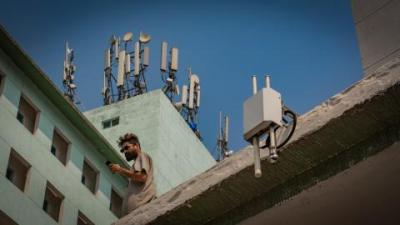
Researchers from IIT Bombay propose algorithms for service providers to efficiently manage the choice of the right network for your mobile devices.
Imagine the frustration when you try to locate your friend in a crowded market—you can neither call them since the cellular signal is terrible nor can you WhatsApp them, as the data connection is also bad. As service providers grapple to cater to high demands of data and voice connections from the ever-growing subscriber base, a combination of cellular and Wi-Fi networks could come to the rescue. Called heterogeneous networks, or HetNets, they are set to change the face of the communication as we know it. In a recent study, Arghyadip Roy, Prof. Prasanna Chaporkar and Prof. Abhay Karandikar from the Indian Institute of Technology Bombay, have proposed two algorithms that can improve data speeds for users and reduce call blocking using HetNets.
Today, Wi-Fi is available in most public places, thanks to hotspots. Although generally Wi-Fi provides higher data speed compared to cellular network and is cost-effective, its data rate starts to drop when many people connect to a single hotspot. On the other hand, if the number of data connections increases in a cellular network, it may lead to voice call blocking. The next-gen 5G communications technology tries to address these limitations.
One approach that can ensure better management of data and voice calls is having a central controller that monitors the connections at each cell tower or Wi-Fi access point and decides if a data or voice call should be served using mobile network or Wi-Fi. This approach can ensure optimal data utilisation, and the service provider can provide better data transfer rates and quality of voice calls to the consumers. “Controlling the access networks through a central, cloud-based controller is the future of mobile networks. People want to have the entire picture of the network and make decisions based on that,” says Prof. Chaporkar.
In this study, published in the journal IEEE Transactions on Vehicular Technology, the researchers propose two fast and efficient algorithms to choose between Wi-Fi and cellular data for devices in a network. At any given time, if a user connects to or disconnects from a network, the central controller chooses specific actions, driven by the policy (a table of system states and corresponding actions), from a set of possibilities.
As opposed to data, a voice call needs a dedicated channel capacity to avoid garbled voices. If it is not available, the voice calls can be blocked, and this probability increases with the increase in the number of users in a cell of the cellular network. There are also government regulations on the maximum call blocking allowed in a network, which the service providers need to adhere. Thus, when a user enters or leaves a network, the central controller needs to reallocate channel capacity such that users see optimal data transfer rate while ensuring that the fraction of voice call blocking is within the specified limit. This process may also involve moving a Wi-Fi connected data user to cellular data connection or vice versa. However, finding the best strategy for allocation could be computationally intensive and take a long time.
“Our target is to find the policy which makes maximum utilisation of the system. Thus, each user can get the best data rate possible while ensuring that the fraction of voice calls blocked stay within specified limit”, explains Prof. Chaporkar.
The researchers of the current study have modelled the process of choosing the best policy as a ‘Markov Decision Process’. In this process, the transition of a system depends only on its current state and previous states are thought to have no implications for its next move. The researchers eliminated a subset of non-optimal policies, thus reducing their number to make a choice. Therefore, the proposed algorithms run faster and use lesser computational resources. The first algorithm selects a strategy based only on allocating network resources to ensure optimum data transfer rates, without considering the probability of voice call blocking. The second one takes into account the constraint that the system can reject only up to a threshold fraction of voice calls.
The researchers compared the results of the simulations of their algorithms with a set of existing algorithms. They found that the first algorithm had a higher probability of voice call rejection than the existing ones. However, the possibility of call rejections was kept below the specified constraint for the second algorithm. Both the algorithms performed better than the existing ones in improving the total system throughput.
As we look forward to the next generation communication technology, the 5G network with central network controllers, smart and computationally efficient algorithms are set to play an essential role in making most of the network resources. As a next step, the researchers of the study plan to enhance their algorithms to take into account the behaviour of the wireless signal before it reaches mobile devices.
Prof. Prasanna S Chaporkar
Prof. A Karandikar
